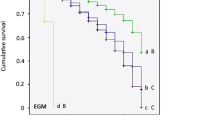Abstract
In high-density populations, the male gypsy moth (Lymantria dispar) “appetitive” flight is primarily vertical and within 1–50 cm of tree boles. Preceding location of a female, males land on trees or occasionally tree foliage and walk while wing-fanning. In high-density populations females may mate before calling, often prior to wing expansion or hardening. Additional matings may occur before any or full deposition of egg masses. Virgin females are not coy, whether their wings are unexpanded, or hardened and held rooflike, or whether they are calling or not. They generally mate with the first willing male and do not exercise sexual selection by an acceptance or rejection reaction. The mating structure in dense populations would seem to reduce selective pressure for female emission of and direct male anemotactic flight to attractant pheromone. A low proportion of males “search” appropriate objects, especially tree trunks, in the walking-wing-fanning state. Such males often are successful in locating virgin females before calling commences. This male strategy presumably would not be successful in low population densities.
Similar content being viewed by others
References
Baker, T.C., andCardé, R.T. 1979. Analysis of pheromone-mediated behaviors in maleGrapholitha molesta, the Oriental fruit moth (Lepidoptera: Tortricidae).Environ. Entomol. 8:956–968.
Boggs, C.L., andGilbert, L.E. 1979. Male contribution to egg production: First evidence for transfer of nutrients at mating in butterflies.Science 206:83–84.
Cardé, R.T. 1981. Precopulatory sexual behavior of the adult gypsy moth, Chap. 6.4, 572–587,in: C.C. Doane and M.L. McManus (eds.). The Gypsy Moth: Research toward Integrated Pest Management. U.S. Dept. Agric. Tech. Bull. 1584 Washington, D.C.
Cardé, R.T., andBaker, T.C. 1984. Sexual communication with pheromones,in W.L. Bell and R.T. Carde (eds.). Chemical Ecology of Insects. Chapman and Hall. pp. 355–383.
Cardé, R.T., andWebster, R.P. 1979. Variation in attraction of individual male gypsy moths to (+)- and (−)-disparlure.J. Chem. Ecol. 5:935–939.
Cardé, R.T., Doane, C.C., andRoelofs, W.L. 1973. Natural inhibitor of the gypsy moth sex attractant.Nature 241:474–475.
Cardé, R.T., Comeau, A., Baker, T.C., andRoelofs, W.L. 1975a. Moth mating periodicity: temperature regulates the circadian gate.Experientia 31:46–48.
Cardé, R.T., Doane, C.C., Granett, J., andRoelofs, W.L. 1975b. Disruption of pheromone communication in the gypsy moth: Some behavioral effects of disparlure and an attractant modifier.Environ. Entomol. 4:793–796.
Cardé, R.T., Doane, C.C., Baker, T.C., Iwaki, S., andMaruno, S. 1977. Attractancy of optically active pheromone for male gypsy moths.Environ. Entomol. 6:768–772.
Charlton, R.E., andCardé, R.T. 1982. Rate and diel periodicity of pheromone emission from female gypsy moths, (Lymantria dispar) determined with a glass-adsorption collection system.J. Insect Physiol. 28:423–430.
Doane, C.C. 1968. Aspects of mating behavior of the gypsy moth.Ann. Entomol. Soc. Am. 61:768–773.
Miller, J.R., Mori, K., andRoelofs, W.L. 1977. Gypsy moth field trapping and electroan-tennogram studies with pheromone enantiomers.J. Insect Physiol. 23:1447–1453.
Plimmer, J.R., Schwalbe, C.P., Paszek, E.G., Bierl, B.A., Webb, R.E., Marumo, S., andIwaki, S. 1977. Contrasting effectiveness of (+) and (−) enantiomers of disparlure for trapping native populations of the gypsy moth in Massachusetts.Environ. Entomol. 6:518–522.
Richerson, J.V. 1977. Pheromone-mediated behavior of the gypsy moth.J. Chem. Ecol. 3:291–308.
Richerson, J.V., Brown, E.A., andCameron, E.A. 1976a. Pre-mating sexual activity of gypsy moth sales in small plot field tests (Lymantria (=Porthetria)dispar (L.): Lymantriidae)Can. Entomol. 109:439–448.
Richerson, J.V., Cameron, E.A., andBrown, E.A. 1976b. Sexual activity of the gypsy moth.Am. Midl Nat. 95:299–312.
Taylor, O.R. 1967. Relationship of multiple mating to fertility inAtteva punctella (Lepidoptera: Yponomeutidae).Ann. Entomol. Soc. Am. 60:503–590.
Author information
Authors and Affiliations
Additional information
Michigan Agricultural Experiment Station Journal Article No. 10253.
Rights and permissions
About this article
Cite this article
Cardé, R.T., Hagaman, T.E. Mate location strategies of gypsy moths in dense populations. J Chem Ecol 10, 25–31 (1984). https://doi.org/10.1007/BF00987640
Received:
Revised:
Issue Date:
DOI: https://doi.org/10.1007/BF00987640




